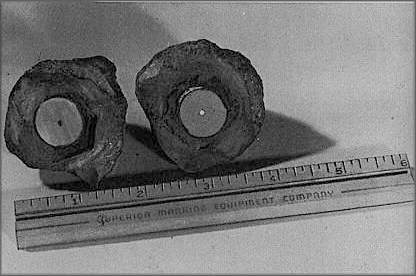 |
| A cut view of the Coso Artifact |
The Coso Artifact is an item known as an "out of placeartifact." Out of place artifacts are essentially modern objects found in
places where they do not belong, hinting at the possibility of modern
technology having been around long before modern man developed it. In the case
of the Coso Artifact, the item was found inside of a stone or lump of hardened
clay. Proponents for the Coso Artifact as an out of place artifact say that the
material in which it was discovered is too old to have held such an item. Estimates
put the material at around 500,000 years old. However, there is another side of
the story.
The Coso Artifact was found by rock and geode hunters Mike
Mikesell, Virginia Maxey and Wallace Lane. On February 13, 1961, the trio was
hunting for geodes to sell in their gift shop. They hunted in the area of
Olancha, California and then brought their finds back to the shop to be sorted
and cut. When one of the "geodes" was cut, a cylinder of metal and
ceramic was found inside. One of the discoverers of the item said that an
archaeologist dated the material to 500,000 years ago. It was also said that it
might be hardened clay and that it also contained what looked like a nail and a
washer.
The date of the Coso Artifact relies on the assumption that
it is a geode. The only known thorough physical examination of the Coso
Artifact found that the material was too soft to be a geode. It also lacked the
telltale quartz crystals found in geodes. Some softer materials can form
around a modern item relatively quickly, whereas a geode cannot. That renders
the age estimate not necessarily incorrect, but based on a faulty belief. The
most telling part of the examination came with an x-ray of the item inside. It
revealed that the metal was a cylinder with a screw-like item on one end and a
flare on the other end.
Since the time of that investigation, the Coso Artifact has
disappeared. The three individuals who found it are not talking about it and
one may have since passed away. Nonetheless, the first investigation and the
photos (including x-ray photos) that resulted have made it possible for experts
to make some interesting discoveries about the item. Not only is it widely
known that the photos do not show a modern item inside of a geode, the item
inside the geode has been identified.
Pacific Northwest Skeptic Pierre Stromberg took an interest
in this supposedly out of place artifact and decided to look into it. Unable to
use the Coso Artifact itself as a point of reference, he used the photos and
x-rays that were taken of the item decades earlier. It had been proposed that
the item was a spark plug, as it displayed many of the characteristics of a
spark plug. However, the screw-like end posed a problem. He contacted the Spark
Plug Collectors of America, asking them to identify it, if possible. He
received word back that the item had been positively identified as a 1920s
Champion spark plug. There was no doubt in the man's mind and other spark plug
collectors have confirmed that the Coso Artifact is indeed a spark plug, just
designed differently than the spark plugs we use today.
Along with the nail and washer mentioned by one of the
people who discovered the Coso Artifact, the idea of it being a piece of
hardened clay that formed in some kind of work yard becomes the most logical
explanation. A professional examination of the Coso Artifact would certainly
prove or disprove that hypothesis in a matter of minutes. Unfortunately, that
is not currently possible. It seems unlikely that it was a hoax, given the
hands-off approach that the discoverers have taken over the past few years. It
seems it was simply mistaken for something that it was not. In fact, even
Maxley said that was a possibility.
Source
Coso Artifact, retrieved 1/28/12,
badarchaeology.com/?page-id=223
Stromberg, Pierre, The Coso Artifact, retrieved 1/28/12,
talkorigins.org/faqs/coso.html
No comments:
Post a Comment